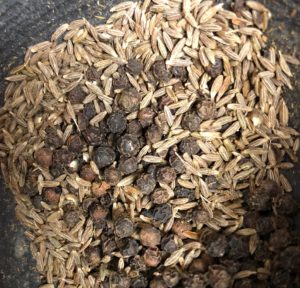
This holiday weekend, in addition to remembering Atlanta’s most famous son, my family celebrated Pongal.
Both a food and a festival, Pongal is celebrated every January in the south Indian state Tamil Nadu. Very much like a South Indian Thanksgiving, Pongal (the festival) is a time when Tamils celebrate and give thanks for a bountiful harvest. The details of the celebration may vary some from place to place, but a universal hallmark of the celebration is the preparation of pongal (the food), so named for the rice and water that boil over the edge (pongu) of their cooking vessel.
In the area that my family is from, the four days of Pongal are called Sankaranthi, Thai Pongal, Maatu Pongal, and Kaanum Pongal. My parents tell me of the traditions that they followed on each of those days: housecleaning and whitewashing on Sankaranthi, followed by decorations with bundles of neem leaves and flowers; gathering around a fire with their families to make pongal in a new pot on Thai Pongal; feeding pongal to the hardworking maatu (cows) on Maatu Pongal; and visiting friends and family on Kaanum.

Since immigrating stateside, my parents have had to modify how they celebrate this beloved festival. The cold winter here means that flowers come from the grocery store; and, living oceans away from the family farm, we don’t have any local cows to feed. But on Thai Pongal, we still make pongal, pray, and give thanks.
My mother prepares two types of pongal: ven pongal, which is savory and usually eaten with a chutney or sambaar (lentil curry), and sweet pongal. Both have a thick, risotto-like consistency. Unlike most people, my mother prepares the rice and lentils for both flavors in one pot before seasoning each separately. While this isn’t exactly a traditional method of preparation, it certainly is faster, and still yields flavorful results.

Some notes from my mother:
- She made the pongal using an Instapot and feels that twenty-five minutes might have been longer than necessary—let her know if you try a shorter time.
- If you don’t have an Instapot, you could also use a pressure cooker (cook until 4-5 whistles) or a rice cooker (cook until warm) to keep preparation easy
- The amount of dahl can be doubled or halved depending on your preference
- No toasted cashews? Chop your cashews and add them first to your butter, toast for 2-3 minutes before adding the other ingredients for the seasoning.
- Turbinado sugar is preferred as being closer to the traditional sugar used for sweet pongal, but brown sugar is an acceptable substitute if turbinado sugar is unavailable
- Not sure how to make this vegan…. as the celebration of cows and dairy is a part of the Pongal celebration (there’s a whole day for the cows!), the butter is important.
Sasi’s Easy Ven and Sweet Pongal
Feeds 4-6 people

Ingredients:
For the pongal base:
- 2 cups long-grain rice
- 1 cup moong dahl
- 1 tbsp salt
- 5 cups water
Ven (savory) pongal seasoning:
- 1/3 cup toasted chopped cashews
- 3 stalks curry leaves (~30-40 leaves; my mother grows her own, but you can find them at an Indian grocer)
- 1 tbsp grated ginger
- 1 tbsp whole cumin seed
- 2 tsp whole black peppercorn
- 3 tbsp butter
Sweet pongal seasoning:
- ¼ cup toasted chopped cashews
- 15 green cardamom pods
- ¾ cup turbinado sugar (brown sugar is an acceptable if less traditional substitute)
- 2 tbsp butter
First, prepare the pongal base:
- Toast the dahl in a dry skillet on medium heat until lightly browned.
- Add dahl, rice, and water to your Instapot/pressure cooker/rice cooker. If using Instapot, cook on high pressure for 25 minutes and let it release pressure for at least ten minutes before opening. If using a pressure cooker, bring the water to a boil before adding dahl and rice, then close and cook for 4-5 whistles. If using rice cooker, cook until warm.
- Once finished, reserve 2 cups for sweet pongal, and use the remainder to make ven pongal following directions below:
Season the ven pongal:
- Melt butter in a large pan over low heat.
- While the butter melts, roughly crush the peppercorn and cumin seed using a mortar and pestle (see pic at end).
- Add toasted cashews, peppercorn, cumin seed, ginger, and curry leaves to butter. Toast 2-3 minutes on low heat, until fragrant
- Add to pongal base and mix well.
- Serve hot, usually with sambaar and coconut chutney
Season the sweet pongal:
- Prepare the cardamom: Using a mortar and pestle, roughly crush the pods until the husks split open and the seed inside falls out. Discard the husks, then crush the remaining black seed into a coarse powder (see pic at end). (Note from Saranya: pods are less expensive and yield a fresher, stronger flavor than powdered cardamom from the American grocer, but you could use pre-powdered instead if no access to pods).
- Melt the butter over low heat, add the cardamom and cashews, stir until mixed and then turn off heat.
- In a medium saucepan, mix sugar and water and bring to a simmer. Then add the reserved 2 cups of pongal base. Add butter, cardamom, and cashew. Mix well, stirring so it doesn’t stick to the bottom and burn, for 3-4 minutes until thick enough to stick to the back of a spatula.
- Serve warm.






One reply on “Pongal: The festival, the food”
[…] about Pongal, the Tamil festival of thanksgiving, reminded me of a recipe for cranberry relish that I tried out last Thanksgiving. Today I bring […]